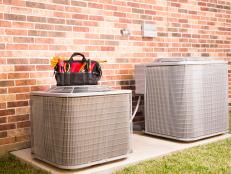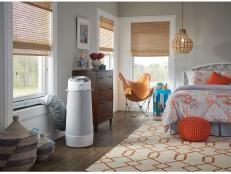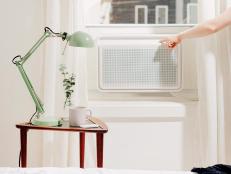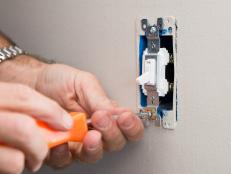How Ductless Air Conditioners Work
Thinking of installing a new ductless HVAC unit or switching out your existing system? Get the 411 on all the pros, cons and details to discover if it's the right choice for you.
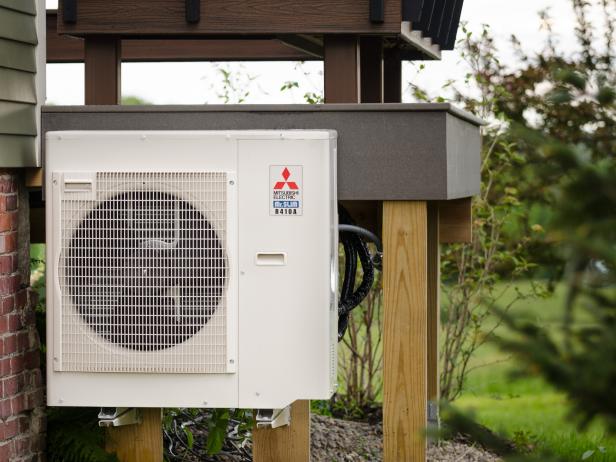
Jason Kisner
Before installing a new ductless air conditioner or switching out your existing system, it’s important to understand how they work.
Simply defined, ductless air conditioning systems (also known as mini-splits) link individual room units to an outdoor compressor. The indoor unit contains evaporator coils cooled with refrigerant. Warm air from the room blows over and is absorbed by the coils. From there, the refrigerant transfers all that inside heat to the outdoor unit.
Instead of a central indoor unit connected by long lengths of ductwork transporting warm and cool air back and forth, a mini-split system places small units directly in each room, which pull in warm air and send it back out as cold air. A popular alternative to traditional air conditioners, mini-splits involve much less intrusive installation, blend in better with the room and are quieter and very energy efficient.
Ductless Capacity
Hold on just a minute. How can little mini-split units cool my whole house? It’s wonderfully simple — the network of indoor units is all connected to one outdoor compressor, which receives the warm air from the house. Once the main unit is installed, you can choose various types of indoor unit options such as ceiling recessed, ceiling register or floor mount to blend in with each room’s personality and needs.
Advantages of Ductless Systems
The biggest advantage of mini-split systems over traditional central air options is ease of installation. A home without existing ductwork requires install of new, and that’s an expensive and complicated endeavor. There are a host of other advantages as well, including:
- Integrated zoning; you get full control of each room’s temperature.
- Mini-splits operate with heat pumps and can heat a room up as well as cool it down.
- Energy-friendly mini-split systems don’t lose air through leaks in ducts. 20-30 percent of energy is lost through ductwork.
- Inverter compressors adjust to the system’s needs instead of shutting down the entire system.
- Inconspicuous presence in a room, and quiet.
Disadvantages of Ductless Systems
It’s not all rosy with ductless systems, of course. Every option has its downsides and mini-splits are no different.
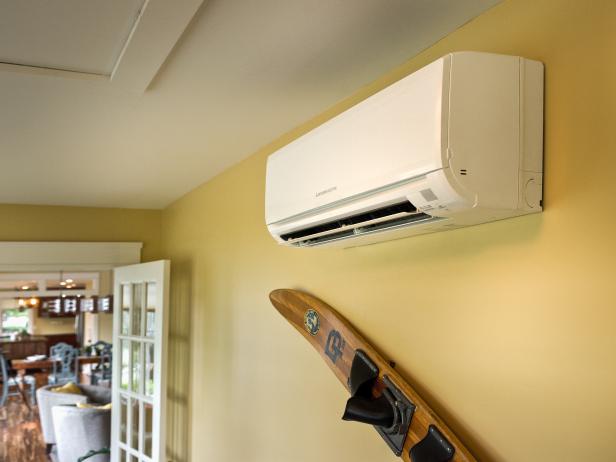
Eric Perry, 2014, DIY Network/Scripps Networks, LLC. All Rights Reserved.
- Expense: Ductless is much more expensive than window or baseboard units.
- Aesthetics: Mini-splits are not especially conducive to room design and usually only come in white or beige.
- Maintenance: Ductless systems require monthly cleaning of filters to get rid of dust and debris.
- Climate concerns: Homeowners in very cold climates might need a fuel backup to run ductless heat.
What Size Do I Need?
Deciding on the best size unit for your needs is the easy part. Simply calculate a room’s square feet and include additional area such as closets. Then consult a sizing chart to determine BTUs required for that space. Here is an abbreviated list of BTU capacity:
- Space to Be Cooled: 150 to 250 sf; Capacity (in BTUs per hour): 6,000
- Space to Be Cooled: 250 to 300 sf; Capacity (in BTUs per hour): 7,000
- Space to Be Cooled: 300 to 350 sf; Capacity (in BTUs per hour): 8,000
All mini-spilt systems are capable of dishing out a specific number of BTUs and once capacity and square footage are taken into account, it’s important to address your home’s insulation situation as well. Naturally, a poorly insulated building is riddled with air leaks and will need a larger system. Common sense tip: It doesn’t do much good to simply throw bigger equipment at a leaky house. Ensure insulation is up to par before proceeding.
External Sizing Factors
Mini-splits operate very well down to about 15 degrees F but if temps plummet to -30 at your northern Minnesota cabin, your system will struggle, condensation coils will freeze and heating will cease. That’s bad. Also keep in mind other factors such as high humidity, drastic hot or cold temperatures, ceiling height and room layout. A large room with blocky wall design or alcoves, for example, may require a second unit to adequately address the room’s cooling and heating needs.







